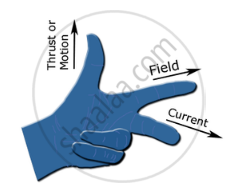Advertisements
Advertisements
Question
force experienced by a current-carrying straight conductor placed in a magnetic field which is perpendicular to it.
Solution
Fleming's left-rule will be used here to find the direction of force experienced by the conductor. According to this rule, when left hand's thumb, forefinger and centre finger are held mutually perpendicular to one another, the forefinger represents the direction of the magnetic field, the centre finger represents the direction of the current and the thumb represents the direction of the force experienced by the coil.

APPEARS IN
RELATED QUESTIONS
Imagine that you are sitting in a chamber with your back to one wall. An electron beam, moving horizontally from back wall towards the front wall, is deflected by a strong magnetic field to your right side. What is the direction of magnetic field?
State Fleming's left hand rule.
Name the rule for finding the direction of magnetic field produced by a straight current-carrying conductor.
What is the shape of a current-carrying conductor whose magnetic field pattern resembles that of a bar magnet?
Name and state the rule to determine the direction of magnetic field around a straight current-carrying conductor.
Draw the magnetic lines of force due to a circular wire carrying current.
List three ways in which the magnetic field strength of a current-carrying solenoid can be increased?
Name one device whose working depends on the force exerted on a current-carrying coil placed in a magnetic field.
A flat coil ABCD is freely suspended between the pole of a U-shaped permanent magnet with the plane of coil parallel to the magnetic field.
Name an instrument which makes use of the principle stated above.
A copper conductor is placed over two stretched copper wires whose ends ate connected to a D.C. supply as shown in the diagram.
- What should be the magnetic poles at the points A and B lying on either side of the conductor to experience the force in the upward direction?
- Name the law used to find these polarities.

